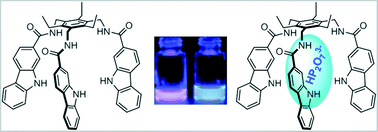Combined study of anion recognition by a carbazole-based neutral tripodal receptor in a competitive environment†
Abstract
Anion recognition studies have been carried out on a series of neutral synthetic receptors in which

* Corresponding authors
a
Department of Organic Chemistry, Faculty of Chemistry, University of Murcia, Campus of Espinardo, 30100-Murcia, Spain
E-mail:
davidcc@um.es
b Department of Organic Chemistry, Faculty of Chemistry, University of Valencia, c/Dr. Moliner, 50 E46100-Burjassot, Valencia, Spain
Anion recognition studies have been carried out on a series of neutral synthetic receptors in which

 Please wait while we load your content...
Something went wrong. Try again?
Please wait while we load your content...
Something went wrong. Try again?
D. Curiel, G. Sánchez, C. Ramírez de Arellano, A. Tárraga and P. Molina, Org. Biomol. Chem., 2012, 10, 1896 DOI: 10.1039/C2OB06868K
To request permission to reproduce material from this article, please go to the Copyright Clearance Center request page.
If you are an author contributing to an RSC publication, you do not need to request permission provided correct acknowledgement is given.
If you are the author of this article, you do not need to request permission to reproduce figures and diagrams provided correct acknowledgement is given. If you want to reproduce the whole article in a third-party publication (excluding your thesis/dissertation for which permission is not required) please go to the Copyright Clearance Center request page.
Read more about how to correctly acknowledge RSC content.
 Fetching data from CrossRef.
Fetching data from CrossRef.
This may take some time to load.
Loading related content
